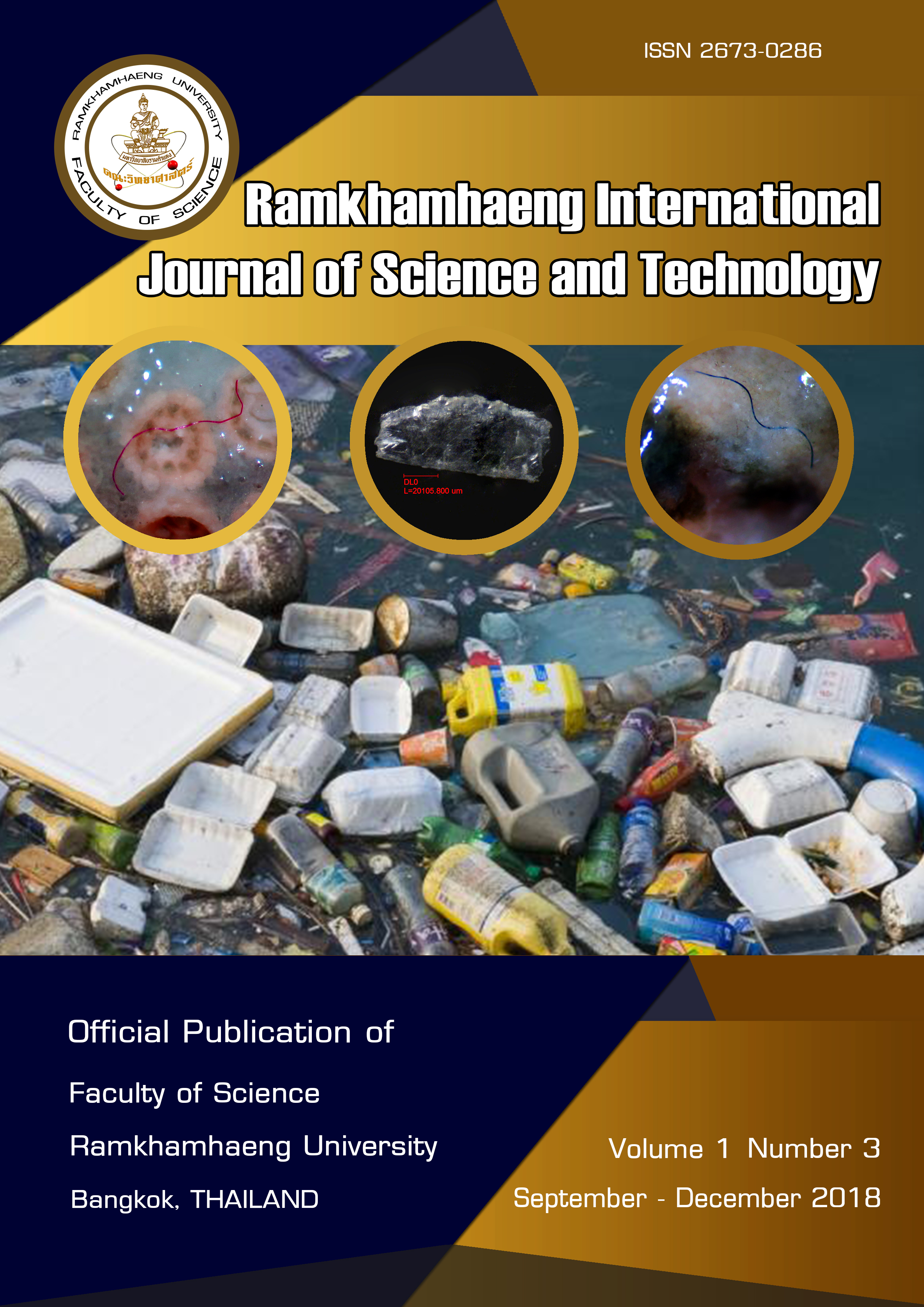Seasonal change of phytoplankton at Hat Pak Meng, the Andaman Sea
Keywords:
phytoplankton, Andaman Sea, diatoms, abundanceAbstract
Phytoplankton is a very important food source for economically important marine organisms, particularly bivalves. However, ecological studies of phytoplankton in Thai waters are quite limited. The seasonal variation of phytoplankton in coastal areas is related to several physicochemical and biological factors. This study aimed to examine the seasonal variation on composition and abundance of phytoplankton at Hat Pak Meng beach, Trang Province, the Andaman Sea. Sampling was carried out during dry (February, March and April) and a rainy season (September, October, November), using a standard 20 μm mesh plankton net with a mouth diameter of 30 cm, equipped with a flow meter, by horizontal hauls during day time. Thirty-one different taxa of phytoplankton were recorded. The dominant phytoplankton groups in the dry season were Coscinodiscus sp., Chaetoceros sp. and Protoperidinium sp., while in the rainy season the last was replaced by Ceratium sp. The fluctuation in rainfall regimes induces changes in physicochemical and biological factors which lead to seasonal variation of the composition of phytoplankton taxa.
References
Berg JA, Newell RI (1986). Temporal and spatial variations in the composition of seston available to the suspension feeder Crassostrea virginica. Estuarine, Coastal and Shelf Science, 23, 375–386.
Chang FH, Vincent WF, Woods PH (1992) Nitrogen utilization by size-fractionated phytoplankton assemblages associated with an upwelling event off Westland, New Zealand. New Zealand Journal of Marine and Freshwater Research. 26: 287–301.
Charoenvattanaporn J, Satapoomin S, Khokiattiwong S, Pholpunthin P, Vongpanich V (2018) Spatial variability in the phytoplankton community along a transect across the Similan islands in the Andaman Sea: A case study 2007-2008. Songklanakarin Journal of Science and Technology. 40(4): 806–818
Costa LS, Huszar VL, Ovalle AR (2009) Phytoplankton functional groups in a tropical estuary: hydrological control and nutrient limitation. Estuaries and Coasts. 32: 508–521.
Cushing DH (1989) A difference in structure between ecosystems in strongly stratified waters and in those that are only weakly stratified. Journal of Plankton Research. 11: 1–13.
Fariñas TH, Bacher C, Soudant D, Belin C, Laurent B (2015) Assessing phytoplankton realized niches using a French National Phytoplankton Monitoring Network. Estuarine Coastal and Shelf Science 159: 15–27.
Heino J, Soininen J (2006) Regional occupancy in unicellular eukaryotes: a reflection of niche breadth, habitat availability, or size-related dispersal capacity? Freshwater Biology, 51, 672–685.
Iqbal TH, Hajisamae S, Khongpuang S (2017) Feeding Habits of Asian Green Mussel (Perna viridis): A Case Study from Andaman Sea and Gulf of Thailand. Proceedings 5th Asian Academic Society International Conference. Khon Kaen University pp. 480–485.
Legendre L, Le Fèvre J (1995) Microbial food webs and the export of biogenic carbon in oceans. Aquatic Microbial Ecology. 9: 69–77.
Litchman E, Klausmeier CA (2008) Trait-based community ecology of phytoplankton. Annual Review of Ecology, Evolution, and Systematics. 39: 615–639.
Livingston RJ (2000). Eutrophication processes in coastal systems: origin and succession of plankton blooms and effects on secondary production in Gulf Coast estuaries. CRC press.
Malone TC (1980) Algal size and phytoplankton ecology. In Morris I (eds), The Physiological Ecology of Phytoplankton. Blackwell Scientific, London, pp. 433–463.
Malone T, Azzaro M, Bode A, Brown E, Duce R, Kamykowski D, Kang SH, Kedong Y, Thorndyke M, Wang J, Park C, Calumpong H, Eghtesadi P (2016). Chapter 6. Primary production, cycling of nutrients, surface layer and plankton. In: The first global integrated marine assessment world ocean. Oceans and Law of the Sea, United Nations.
Nirmal Kumar JI; George B; Kumar RN; Sajish PR, Viyol S (2009) Assessment of spatial and temporal fluctuations in water quality of a tropical permanent estuarine system—Tapi, West coast India. Applied Ecology and Environmental Research. 7(3): 267–276.
Paerl HW, Valdes LM, Pinckney JL, Piehler MF, Dyble J, Moisander PH (2003). Phytoplankton photopigments as indicators of estuarine and coastal eutrophication. BioScience. 53: 953–964.
Pelleyi S; Kar RN, Panda CRP (2008) Seasonal variability of phytoplankton population in the Brahmani estuary of Orissa, India. Journal of Applied Sciences and Environmental Management. 12(3): 19–23.
Smith EM, Kemp MW (2001) Size structure and the production/respiration balance in a coastal plankton assemblage. Limnology and Oceanography. 46: 473–485.
Sokołowskia A, Wołowicza M, Asmusb H, Asmusb R, Carlierc A, Gasiunaitéd Z, Grémaree A, Hummelf H, Lesutienéd J, Razinkovasd A, Renaudg PE, Richardh P, Kędrai M (2012) Is benthic food web structure related to diversity of marine macrobenthic communities?. Estuarine, Coastal and Shelf Science. 108: 76–86.
Stolte W, McCollin T, Noordeloos AA, Riegman R (1994). Effect of nitrogen source on the size distribution within marine phytoplankton populations. Journal of experimental marine biology and ecology, 184: 83–97.
Troccoli L, Herrera‐Silveira JA, Comín FA (2004). Structural variations of phytoplankton in the coastal seas of Yucatan, Mexico. Hydrobiologia, 519: 85–102.
Varela M (1996). Phytoplankton ecology in the Bay of Biscay. Scientia Marina. 60: 45–53.
Varona-Cordero F, Gutierrez-Mendieta FJ, Castillo MEMD (2010) Phytoplankton assemblages in two compartmentalized coastal tropical lagoons (Carretas-Pereyra and Chantuto-Panzacola, Mexico). Journal of Plankton Research. 32(9): 1283–1299.
Winder M, Sommer U (2012) Phytoplankton response to a changing climate. Hydrobiologia. 698: 5–16.
Downloads
Published
Issue
Section
License
Copyright Notice: a copyright on any article in the published journal is retained by the Ramkhamhaeng International Journal of Science and Technology. Readers or Users grant the right to use of the Article contained in the Content in accordance with the Creative Commons CC BY-NC-ND license and the Data contained in the Content in accordance with the Creative Commons CC BY-NC-ND.



